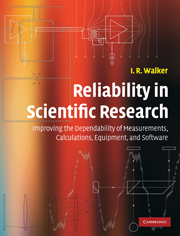 Reliability in Scientific Research
Reliability in Scientific Research Book contents
- Frontmatter
- Contents
- Preface
- List of abbreviations
- 1 Basic principles of reliability, human error, and other general issues
- 2 Mathematical calculations
- 3 Basic issues concerning hardware systems
- 4 Obtaining items from commercial sources
- 5 General points regarding the design and construction of apparatus
- 6 Vacuum-system leaks and related problems
- 7 Vacuum pumps and gauges, and other vacuum-system concerns
- 8 Mechanical devices and systems
- 9 Cryogenic systems
- 10 Visible and near-visible optics
- 11 Electronic systems
- 12 Interconnecting, wiring, and cabling for electronics
- 13 Computer hardware and software, and stored information
- 14 Experimental method
- Index
- References
3 - Basic issues concerning hardware systems
Published online by Cambridge University Press: 05 June 2012
- Frontmatter
- Contents
- Preface
- List of abbreviations
- 1 Basic principles of reliability, human error, and other general issues
- 2 Mathematical calculations
- 3 Basic issues concerning hardware systems
- 4 Obtaining items from commercial sources
- 5 General points regarding the design and construction of apparatus
- 6 Vacuum-system leaks and related problems
- 7 Vacuum pumps and gauges, and other vacuum-system concerns
- 8 Mechanical devices and systems
- 9 Cryogenic systems
- 10 Visible and near-visible optics
- 11 Electronic systems
- 12 Interconnecting, wiring, and cabling for electronics
- 13 Computer hardware and software, and stored information
- 14 Experimental method
- Index
- References
Summary
Introduction
The following chapter discusses a number of important issues that affect many classes of experimental hardware. For instance: vibrations can cause problems with optical, cryogenic, and other apparatus, and overheating may afflict electronic instruments, computers, and numerous other items.
Stress derating
The practice of derating (otherwise known as “providing a margin of safety”) is a means of improving the reliability of devices exposed to physical stresses (including power, temperature, electric current, pressure, etc.). If devices are operated continuously at their rated maximum stress levels, they are not unlikely to undergo failure in a relatively short time. Derating consists of operating them at reduced stress levels, at which the probability of failure is comparatively small. The derating factor of a device is usually expressed as a ratio of the stress needed to achieve good reliability to the rated maximum stress. While the term “derating” is normally used in conjunction with electrical and electronic components, the principle is a general one.
Generally, systems comprising a collection of components (e.g. a power supply or a power amplifier) are not derated as a whole, because derating has (or should have been) already been done for each of the constituent components. That is, derating is usually done at the component level, rather than the system (collection of components) level. (An exception is the temperature derating of power supplies – see below.)
- Type
- Chapter
- Information
- Reliability in Scientific ResearchImproving the Dependability of Measurements, Calculations, Equipment, and Software, pp. 58 - 115Publisher: Cambridge University PressPrint publication year: 2011


